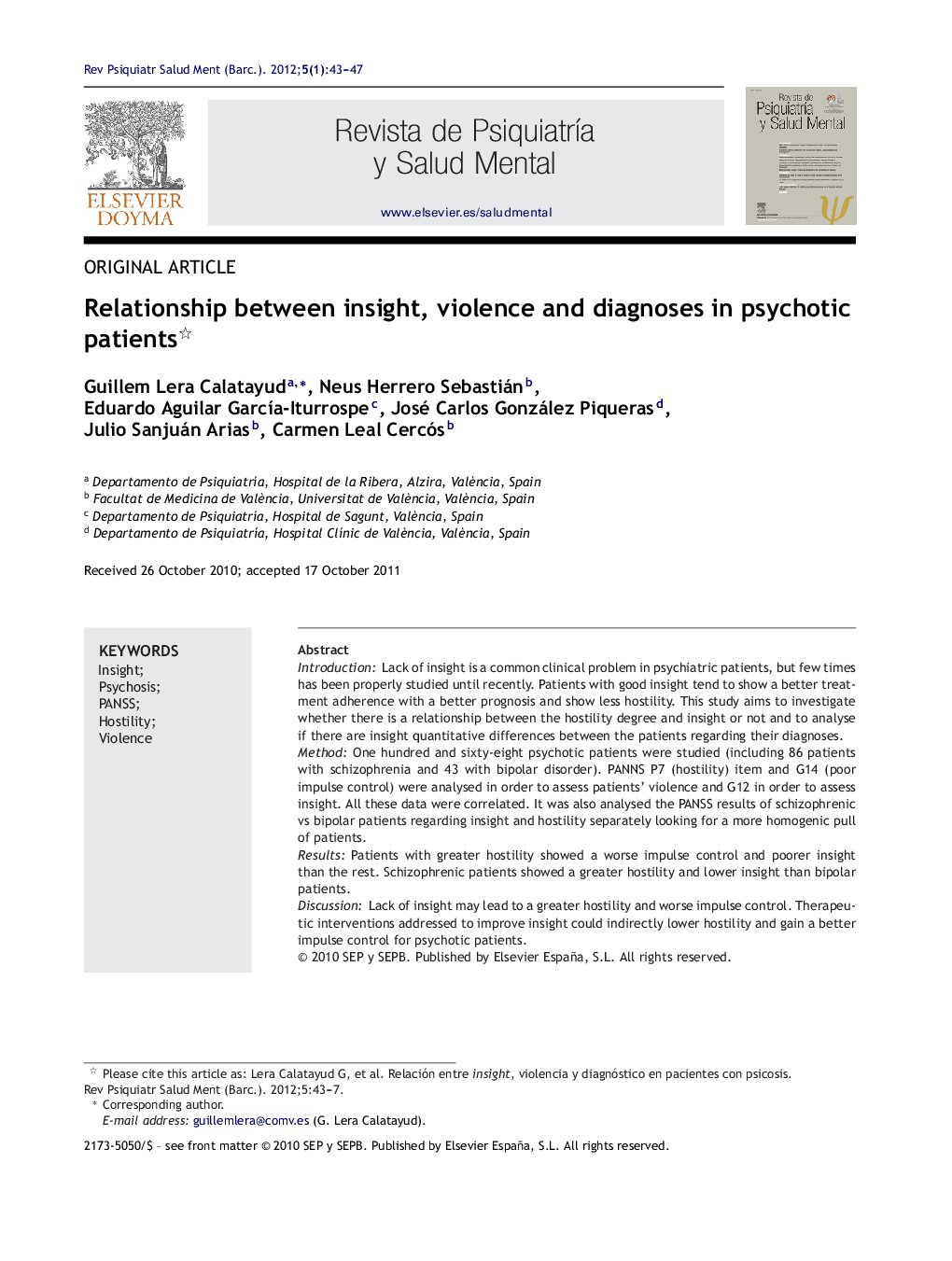| کد مقاله | کد نشریه | سال انتشار | مقاله انگلیسی | نسخه تمام متن |
|---|---|---|---|---|
| 4191443 | 1278279 | 2012 | 5 صفحه PDF | دانلود رایگان |

IntroductionLack of insight is a common clinical problem in psychiatric patients, but few times has been properly studied until recently. Patients with good insight tend to show a better treatment adherence with a better prognosis and show less hostility. This study aims to investigate whether there is a relationship between the hostility degree and insight or not and to analyse if there are insight quantitative differences between the patients regarding their diagnoses.MethodOne hundred and sixty-eight psychotic patients were studied (including 86 patients with schizophrenia and 43 with bipolar disorder). PANNS P7 (hostility) item and G14 (poor impulse control) were analysed in order to assess patients’ violence and G12 in order to assess insight. All these data were correlated. It was also analysed the PANSS results of schizophrenic vs bipolar patients regarding insight and hostility separately looking for a more homogenic pull of patients.ResultsPatients with greater hostility showed a worse impulse control and poorer insight than the rest. Schizophrenic patients showed a greater hostility and lower insight than bipolar patients.DiscussionLack of insight may lead to a greater hostility and worse impulse control. Therapeutic interventions addressed to improve insight could indirectly lower hostility and gain a better impulse control for psychotic patients.
ResumenIntroducciónEn pacientes con trastornos psiquiátricos el déficit en la capacidad de introspección o insight es frecuentemente un problema clínico importante, pero ha sido pocas veces objeto de estudio formal. Los pacientes psicóticos con buen insight suelen cumplir mejor las pautas de medicación siendo un factor de buen pronóstico y muestran menor hostilidad. Con este estudio se pretende valorar si existe una relación entre el grado de hostilidad del paciente y la conciencia de enfermedad además de analizar si el grado de conciencia de enfermedad varía según el diagnóstico del paciente (esquizofrenia vs. trastorno bipolar).MetodologíaSe estudiaron en 168 pacientes psicóticos (entre ellos 86 con esquizofrenia y 43 con trastorno bipolar) los ítems de la PANSS P7 (hostilidad) y G14 (control deficiente de impulsos) para valorar el grado de violencia y el ítem G12 (ausencia de juicio e introspección) correlacionándolos entre ellos. Para observar si había diferencias en cuanto a insight y hostilidad según el diagnóstico, se estudiaron los datos utilizando una muestra más reducida y homogénea comparando los pacientes diagnosticados de esquizofrenia con los diagnosticados de trastorno bipolar.ResultadosLos pacientes con mayor hostilidad presentaban un peor control de impulsos y una pobre conciencia de enfermedad. Los pacientes diagnosticados de esquizofrenia presentan una mayor hostilidad y un peor insight comparados con los diagnosticados de trastorno bipolar.DiscusiónLa ausencia de introspección supondría un mayor nivel de hostilidad y mayor déficit de control de impulsos. Las estrategias terapéuticas encaminadas a aumentar el grado de insight del paciente podrían disminuir indirectamente el grado de hostilidad y proporcionar un mejor control de los impulsos.
Journal: Revista de Psiquiatría y Salud Mental (English Edition) - Volume 5, Issue 1, January–March 2012, Pages 43–47